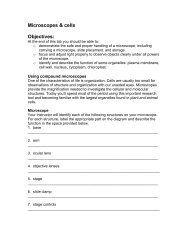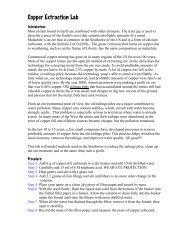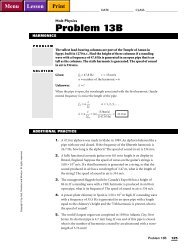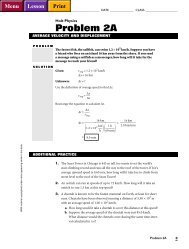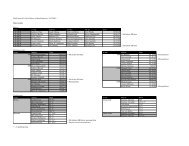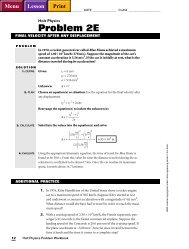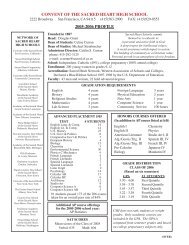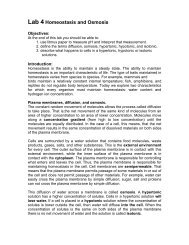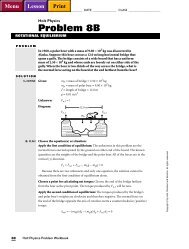Lab 7 DNA and Chromosomes
Lab 7 DNA and Chromosomes
Lab 7 DNA and Chromosomes
You also want an ePaper? Increase the reach of your titles
YUMPU automatically turns print PDFs into web optimized ePapers that Google loves.
<strong>Lab</strong> 7 <strong>DNA</strong> <strong>and</strong> <strong>Chromosomes</strong><br />
Objectives:<br />
At the end of this lab you should be able to:<br />
1. Describe the structure <strong>and</strong> function of <strong>DNA</strong>.<br />
2. Know which bases in <strong>DNA</strong> pair with each other.<br />
3. Define the terms chromatid, chromosome, diploid, <strong>and</strong> haploid.<br />
4. Explain the composition <strong>and</strong> location of genes.<br />
5. Be able to examine a cell <strong>and</strong> identify which stage of mitosis it is in.<br />
<strong>DNA</strong><br />
The unique nature of your <strong>DNA</strong> <strong>and</strong> your life experiences define who you are.<br />
Indeed this molecule defines the structure <strong>and</strong> function of every living cell. The<br />
structure of this molecule reveals how it is duplicated. Soon after this structure<br />
was defined, scientists were able to describe how this molecule is used in the<br />
production of proteins. Now we can actually design genes to make specific<br />
proteins. Before you can underst<strong>and</strong> how we make designer genes, you first<br />
need to underst<strong>and</strong> the nature <strong>and</strong> function of genes; <strong>and</strong> that means<br />
underst<strong>and</strong>ing the nature <strong>and</strong> function of <strong>DNA</strong>.<br />
<strong>DNA</strong> structure<br />
Locate the display (model <strong>and</strong> pictures) of the <strong>DNA</strong> molecule. You may also want<br />
to refer to your textbook. <strong>DNA</strong> forms a double helix that resembles a twisted<br />
ladder.<br />
1. What molecules make up the sides of the ladder<br />
_____________________________________________________________<br />
2. What molecules make up the rungs of the ladder<br />
_____________________________________________________________<br />
3. What keeps the two sides of the ladder paired<br />
_____________________________________________________________<br />
4. <strong>DNA</strong> replication involves splitting the molecule in half. New base pairing with<br />
each half of the original <strong>DNA</strong>, produces two new double helix molecules. With<br />
normal base pairing, what sequence of <strong>DNA</strong> would pair with the following<br />
sequence of <strong>DNA</strong><br />
A T T C G C G A A T<br />
_____________________________________<br />
5. Where is <strong>DNA</strong> located within organisms<br />
_____________________________________________________________<br />
_____________________________________________________________
Naked <strong>DNA</strong> - What does this molecule look like<br />
Instructions for extracting <strong>DNA</strong> (adapted from Scientific American, Sept. 1998)<br />
Use a garlic press to mash fruit. Please thoroughly rinse the garlic<br />
press when you are done.<br />
Place 5 ml of mashed fruit into a small beaker.<br />
Add 10 ml of the chilled buffer.<br />
Stir gently for 2 - 3 minutes<br />
Strain the fruit/buffer mixture through a coffee filter into a beaker.<br />
Pour the strained fruit into a clean test tube.<br />
Add 10 ml of chilled ethanol by slowly trickling the alcohol down the<br />
side of the test tube with a Pasteur pipet. The alcohol should sit on the<br />
top of the fruit.<br />
Chill your test tube in ice for 3 minutes. You should see two distinct<br />
layers in the test tube.<br />
Twirl a <strong>DNA</strong> hook in the bottom section <strong>and</strong> then pull the hook up into<br />
the alcohol. Repeat this process until you no longer obtain additional<br />
<strong>DNA</strong>.<br />
Adding one drop of methylene blue to the test tube should help you<br />
see some str<strong>and</strong>s of <strong>DNA</strong> you might have missed.<br />
6. Why do we mash our raw materials<br />
_____________________________________________________________<br />
_____________________________________________________________<br />
7. The buffer contains 120 ml distilled water, 1/4 tsp salt, 1 tsp baking soda, <strong>and</strong><br />
1 tsp Dawn detergent. What does adding the detergent accomplish<br />
_____________________________________________________________<br />
_____________________________________________________________<br />
8. What happens if you shake or vigorously stir the contents of your test tube<br />
_____________________________________________________________<br />
_____________________________________________________________<br />
9. <strong>DNA</strong> isolated from different organisms has the same appearance to our<br />
unaided eye. So what makes all these different <strong>DNA</strong> molecules different<br />
_____________________________________________________________<br />
_____________________________________________________________<br />
Additional Questions<br />
10. The total <strong>DNA</strong> in one cell is called the genome. Approximately how many<br />
base pairs in the human genome ________________________________<br />
11. Comparisons of the <strong>DNA</strong> of different human beings reveals that about 99.9%<br />
of our <strong>DNA</strong> is identical. So about 0.1% of our <strong>DNA</strong> is unique. How many base<br />
pairs in 0.1% of human <strong>DNA</strong> ________________________________
Chromosome structure<br />
<strong>Chromosomes</strong> have a very specific structure. The diagram below is of a<br />
duplicated chromosome. <strong>Lab</strong>el the following terms on the diagram.<br />
centromere<br />
chromatid<br />
gene<br />
Chromosome number<br />
In organisms that reproduce by sexual reproduction, cells may have either one<br />
complete set of chromosomes (haploid) or two complete sets of chromosomes<br />
(diploid). Complete the following table.<br />
Organism Haploid<br />
Number of<br />
<strong>Chromosomes</strong> (1N)<br />
Organism Diploid<br />
Number of<br />
<strong>Chromosomes</strong> (2N)<br />
Yeast (Saccharomyces 16<br />
cerevisiae)<br />
Corn (Zea mays) 20<br />
Horsetail (Equisetum) 108<br />
Fruit fly (Drosophila 4<br />
melanogaster)<br />
Frog (Rana pipiens) 26<br />
Chimpanzee (Pan 24<br />
troglodytes)<br />
Human (Homo sapiens)
Genes<br />
Genes are the basic units of inheritance <strong>and</strong> consist of a sequence of <strong>DNA</strong>. The<br />
structural region of a gene is a sequence of <strong>DNA</strong> that specifies a sequence of<br />
amino acids (i.e., a sequence of <strong>DNA</strong> base pairs that “code” for a protein. The<br />
control regions of a gene are sequences of <strong>DNA</strong> that determine whether or not a<br />
gene is turned on or off.<br />
12. Where are the genes located<br />
________________________________________________________________<br />
________________________________________________________________<br />
13. The entire set of genes for one organism is called its genome. Approximately<br />
how many genes in the human genome ___________________<br />
14. Which human chromosome is the biggest _____ the smallest ______<br />
Chromosome Base pairs Genes Chromosome Base pairs Genes<br />
1 245,203,898 2610 13 114,151,656 496<br />
2 243,315,028 1748 14 105,311,216 1173<br />
3 199,411,731 1381 15 100,114,055 906<br />
4 191,610,523 1024 16 89,995,999 1032<br />
5 180,967,295 1190 17 81,691,216 1394<br />
6 170,740,541 1394 18 77,753,510 400<br />
7 158,431,299 1378 19 63,790,860 1592<br />
8 145,908,738 927 20 63,644,868 710<br />
9 134,505,819 1076 21 46,976,537 337<br />
10 135,480.874 983 22 49,476,982 701<br />
11 134,978,784 1692 X 152,634,166 1141<br />
12 133,464,434 1268 Y 50,961,097 255
You will be given a practice sheet with cells in various stages of mitosis. One<br />
side of the sheet is of plant cells (onion root tip), <strong>and</strong> the other is of animal cells<br />
(a whitefish embryo). Please examine them, <strong>and</strong> label each cell with its stage.<br />
After we review; you will obtain a prepared slide of both onion root tip <strong>and</strong><br />
whitefish embryo. Focus all the way up to high power, <strong>and</strong> find at least two cells<br />
in each stage. Draw sketches below.<br />
Interphase<br />
Major Events Onion Root Tip Whitefish Embryo<br />
Prophase<br />
Metaphase<br />
Anaphase<br />
Telophase




